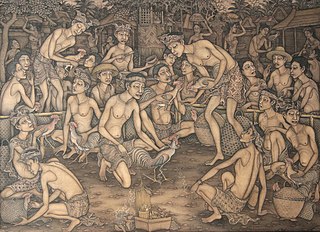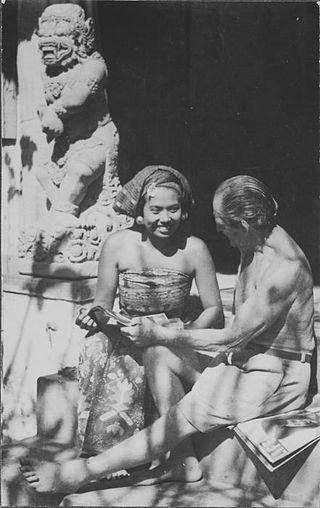Related Research Articles

The Balinese people are an Austronesian ethnic group native to the Indonesian island of Bali. The Balinese population of 4.2 million live mostly on the island of Bali, making up 89% of the island's population. There are also significant populations on the island of Lombok and in the easternmost regions of Java.
Adrianus Wilhelmus "Arie" Smit was a Dutch-born Indonesian painter who lived on Bali.
I Ketut Soki is a successful artist from Bali. As a boy, he was one of the first two children to receive art lessons from the famous artist Arie Smit, and so one of the founders of the "Young Artists" movement.

Balinese art is art of Hindu-Javanese origin that grew from the work of artisans of the Majapahit Kingdom, with their expansion to Bali in the late 14th century. From the sixteenth until the twentieth centuries, the village of Kamasan, Klungkung, was the centre of classical Balinese art. During the first part of the twentieth century, new varieties of Balinese art developed. Since the late twentieth century, Ubud and its neighboring villages established a reputation as the center of Balinese art.

Museum Rudana or Rudana Art Museum is an art museum in Peliatan, Gianyar Regency, Bali, Indonesia. It was built by Nyoman Rudana, following the concept of the Bali humanist philosophy of Tri Hita Karana, where art makes a contribution to public wellbeing.
Nyoman Rudana is a former member of the Regional Representatives Council of Indonesia. He is also the founder and owner of Museum Rudana, Rudana Fine Art Gallery and Genta Fine Art Gallery, and founder of artist support organizations in Ubud, Bali.
I Nyoman Masriadi is a painter and a leading artist of the post-Suharto era in Indonesia. His works have gained a collectors base which includes prominent collectors in and around the region.

Adrien-Jean Le Mayeur de Merprès was a Belgian painter from Ixelles who lived the last part of his life in Bali.

Ida Bagus Made Poleng (1915–1999) was a traditional Balinese painter. Known also as Ida Bagus Made Poleng or Ida Bagus Made Tebesaya or simply Gus Made.
Anak Agung Gde Sobrat (1912–1992) was a painter in Indonesia.
I Gusti Nyoman Lempad (1862?–1978) was a Balinese stone sculptor, architect and painter who built palaces and temples in Ubud and its neighboring villages. Lempad's exact birth date, as is the case for many Balinese of his time, is unknown. But he was married when Krakatoa erupted in 1883.
Ida Bagus Made Togog (1913–1989) was born into a noble Brahmana clan in the center of Batuan. Together with I Ngendon, he was one of the foremost painters from Batuan. Unlike Ngendon, Togog was not particularly interested in Western ideas. He was comfortable with the Balinese way of life and adhered closely to the Balinese belief system. As a member of the high priest family, Togog was very familiar with Balinese lontar and Balinese myths and folklore. His works were primarily drawn from religion and local myths from an insider's view point and he narrates them through his drawings, just like in the Wayang tradition. The strength of his drawings was neither his draftsmanship nor composition, but his narration of complex religious beliefs and the united life in Bali as a balance between the macrocosm and microcosm, between the benevolent and good spirits. According to Wim Bakker, it was the Dutch painter Rudolf Bonnet, who inspired him to translate images in Balinese lontars into drawings. During 1936 to 1938, he was befriended by Gregory Bateson and Margaret Mead and produced 83 paintings for them. As Bateson and Mead went to Bali to do research on Balinese character, they requested Togog to give an expression of his dreams. He produced a large number of drawings on dreams and his own interpretation in the context of Balinese beliefs as he understood it.
Ida Bagus Nyoman Rai (~1915-2000) was a traditional Balinese painter from Sanur, a beach resort near Denpasar, Bali, Indonesia. He was also known as I Bagus Nyoman Rai Tengkeng or Ida Bagus Nyoman Rai Klingking

The Neka Art Museum is a museum located in Ubud on Bali, Indonesia, It was established in 1982 by Pande Wayan Suteja Neka, better known as Suteja Neka, a Balinese art dealer who had begun collecting Balinese art with the advice and help of painters Rudolf Bonnet and Arie Smit among others.

Batuan is a village in Bali, Indonesia. It is noted for its artwork and style of painting which originated in the village in the 1930s and has since emerged into a major Balinese artistic style, known as a Batuan painting. It is a major painting center and contains a number of art galleries and cooperative art societies which have played a key role in promoting the art of Batuan. The village is also known for its performance of the ancient Gambuh dance, performed every Full Moon day.

Gambuh is an ancient form of Balinese dance-drama. It is accompanied by musicians in a gamelan gambuh ensemble.

Semarapura is a town which serves as the administrative capital of the Klungkung Regency in Bali, Indonesia.

Indonesian painting has a very long tradition and history in Indonesian art, though because of the climatic conditions very few early examples survive, Indonesia is home to some of the oldest paintings in the world. The earliest Indonesian paintings were the rock paintings of prehistoric times, such as the petroglyphs found in places like in the caves in the district of Maros in Sulawesi, Indonesia. The Stone Age rock paintings found in Maros Cave are approximately 40,000 years old and are listed as one of the oldest paintings in the world.
References
- ↑ Höhn, Klaus (1997). Reflections of Faith: The History of Painting in Batuan, 1834-1994: The Art of Bali. Published by Pictures Publishers Art Books.
- ↑ Geertz, Hildred (1994). Images of Power: Balinese Paintings Made for Gregory Bateson and Margaret Mead . University of Hawaii Press. ISBN 978-0-8248-1679-7.
- ↑ Haks, Frans; Kunsthal Rotterdam (1999). Pre-war Balinese Modernists, 1928-1942. Ars et Animatio. ISBN 90-5349-297-6.